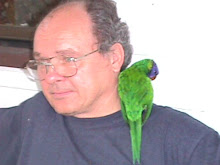 the master kitchen-cum-lounge until the house arrived
the master kitchen-cum-lounge until the house arrived Allen Road was always going to be a retreat, a haven far from the madding crowd, our own piece of [albeit slightly flawed] paradise, a place to which we could escape from the growing urban Rat Race, where the birds would come to us rather than we having to trot around Australia, nay, the globe, in search of birds.
We’d scoured the Sunshine Coast hinterland, later infamous for the State Government compulsory purchases of land along the Mary River. At Gympie we turned inland, making our way from Kilkivan to Goomeri [famed for its cheese shop] and onto Kingaroy [where having purchased a bottle of house wine the owner then wanted to charge us additional corkage]. We ventured further into the South Burnett: Nanango, Yarraman and Blackbutt – we’d passed the latter two townships back in the 1990s in our search for Black-breasted Button-quail [finally tracking down the species in the Yarraman State Forest].
By the third weekend we’d narrowed the field of possible properties down to three. A closer examination of one of these revealed serious engineering defects in the dam. That left two.
One, in East Nanango, and preferred by Fay, was a 5-acre block atop a high hill with magnificent scenic views. It had good rich red soil and although there was no obvious source of fresh water I did note that the abutting property had a bore. It lay a stone’s throw from the East Nanango State Forest, only a little further from the Nanango Fauna Sanctuary. We made an offer knowing that the place had been on the market for a little over a year.
That had been a Sunday afternoon. The following Monday evening we receive a telephone call from the real estate agent to inform us that there had been a counter offer on the property several thousands dollars above ours. We simply advised the agent that if the new bidder wanted the property that much then we would pull out. He did sound a little peeved but the property was still on the market several months later when Fay and I managed our first visit to the State Forest.
The other property, in South Nanango, was a little larger at 7½ acres, much lower lying [nevertheless still above 400m asl], with very poor heavy clay soils and a submerged rocky ridge running down the western boundary. On the other hand it had a huge 33m diameter dam,
The dam c.2001

a 12x6m tin shed,

was unkempt with several tall gums and ironbarks

and grasses taller than our car. It was one of a number of properties along Allen Road but retained its “isolated” feel – and we were looking for a birding retreat not looking to become small hobby farmers.
If there were any lingering doubts they rapidly dissipated when a pair of Wedge-tailed Eagles appeared from over the tall gums and seemingly glided down as if to take a closer look at the odd humans below.
We put in a offer and the rest, as they say, is history.
That was in April 2001 [our Backyard List dates back to those days]. True to our original vision we began to make the long 2½-hour trek from Redcliffe on more or less a fortnightly basis, more often when we managed to share a holiday period.
Shortly after, I drove our old campervan and parked it in the shed. It became our bedroom. In summer, with temperatures exceeding 40
0C under the metal roof, we relocated the campervan outside, on the south side of the shed and were awaken each morning by Double-barred Finches, fossicking for titbits immediately outside our new bedroom.
The house came in May 2002

and by 2005 we were ready to uproot from Redcliffe and make a permanent move to Nanango. Fay came in March, I had to wait until the end of that school year [mid-December].
And so, here we are, on our own piece of flawed heaven but with a Backyard List of more than 150 species.
This blog, a subset of
www.birdingsouthburnett.blogspot.com, will simply highlight a few of the more interesting sightings at Allen Road – birds seen on or flying over the property, together with any noted along the length of the road itself [together with those in “Des’s Paddock” on our southern boundary].
We have our current “Earlybirds: precursors to sunrise” project, along with our increasing plantings of she-oak, casuarinas, to encourage more frequent visitations from the darlings of the Backyard List, the Glossy Black-Cockatoos.
.jpg) The house today viewed from the north
The house today viewed from the north






.jpg)
